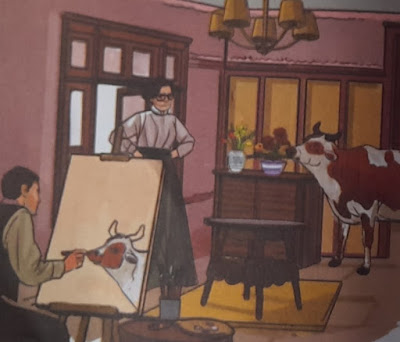4.
Theophil Eshley studied the ox like an artist. What all did he notice?
Theophil
Eshley was an artist. He took to painting cows. One day his neighbor asked him
to remove an ox from her garden. He went to her garden and saw a huge spotted
ox in the garden. The ox was dull red about the head and shoulders. The ox's
flanks and hindquarters were dirty white. The ox had shaggy ears and large
blood-shot eyes.
5.
What efforts did Theophil Eshley make to drive the ox away? What was the
reaction of the ox?
Theophil
Eshley tried to drive away the ox by making sound by clapping and shooing. The
ox hadn't given any indication of moving. Then Eshley picked up a pea stick and
flung it towards the ox. Realizing that he had to move the ox pushed its way
through the French window into Adela's morning-room.
7.
The episode was the turning point in Eshley's artistic career. Which
episode is being talked about here? How was it a turning point?
The
episode of Eshley's efforts to drive the ox away from Adela's garden resulted
in the remarkable picture, "Ox in a morning-room, late autumn,"
It was one of the sensations and successes of the next Paris Art
Exhibition, and when it was later exhibited at Munich it was bought by the
Bavarian Government. From that moment, his success was continuous and
assured.
8.
Discuss the title of the story.
The
title of the story, 'the stalled ox' is quite appropriate. The word 'stalled'
means to stop suddenly. In the story an ox had stalled in a neighbor's garden.
The ox enters Adela Pingsford's garden and starts eating her flower plants. The
ox refuses to leave in spite of Eshley's efforts to shoo him away. Instead of
going out, the ox enters the morning-room and stays there long enough for
Eshley to paint his masterpiece.
